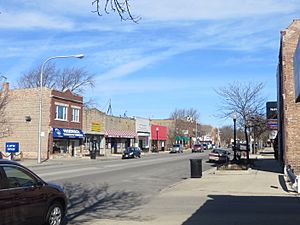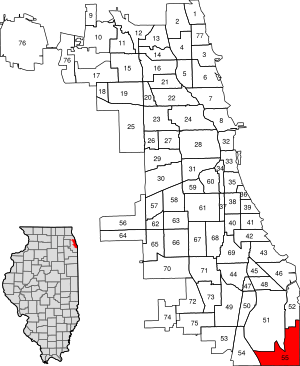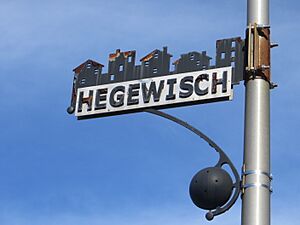Hegewisch, Chicago facts for kids
Quick facts for kids
Hegewisch
|
|
|---|---|
| Community Area 55—Hegewisch | |

Baltimore Avenue is the main commercial street of Hegewisch.
|
|

Location within the city of Chicago
|
|
| Country | United States |
| State | Illinois |
| County | Cook |
| City | Chicago |
| Neighborhoods |
list
Arizona
Avalon Trails Hegewisch Harbor Point Estates Old Hegewisch |
| Area | |
| • Total | 4.78 sq mi (12.38 km2) |
| Population
(2020)
|
|
| • Total | 10,027 |
| • Density | 2,097.7/sq mi (809.9/km2) |
| Demographics 2020 | |
| • White | 36.7% |
| • Black | 6.8% |
| • Hispanic | 56.2% |
| • Asian | 0.0% |
| • Other | 0.2% |
| Time zone | UTC−6 (CST) |
| • Summer (DST) | UTC−5 (CDT) |
| ZIP Code |
60633
|
| Median income 2020 | $57,847 |
| Source: U.S. Census, Record Information Services | |
Hegewisch (pronounced "heg-wish") is one of the 77 special areas in Chicago, Illinois. It's located on the far south side of the city. This community area is named after Adolph Hegewisch. He was the president of a company called U.S. Rolling Stock Company. In 1883, he wanted to create "an ideal workingman's community" here. Chicago officially took over the town six years later.
Contents
History of Hegewisch
Early Beginnings
In 1837, Hegewisch became part of Hyde Park Township. This township also included most of what is now the South Side of Chicago.
In 1883, Adolph Hegewisch chose this area for his company town. He planned to build two canals. One would make the Calumet River shorter. The other would connect Wolf Lake to Lake Michigan. However, he never built these canals because he didn't have enough money. In 1889, Hyde Park Township voted to join the City of Chicago. A few years later, Adolph Hegewisch passed away. His company then became part of the Pressed Steel Car Company.
Steel Mills and Workers' Rights
In the early 1900s, many steel mills opened in Hegewisch. A large number of Polish immigrants moved to the area to work in these mills. In the 1930s, the Steel Workers Organizing Committee became active here. They helped workers get better conditions.
Eventually, this union was recognized by the Carnegie-Illinois Steel Company. This made the union stronger. They then organized a strike against smaller steel companies. During a march, workers were met by the Chicago Police Department. Sadly, ten unarmed workers died, and many more were hurt.
Changes and Challenges
Starting in the 1970s, fewer people worked in the steel industry. This hurt areas like Hegewisch that depended on steel mills. In 1980, the Wisconsin Steel mill closed. This led to many people losing their jobs. More factory closures followed, making the problem worse.
During this time, different ideas for new businesses were suggested. In 1990, Mayor Richard M. Daley proposed building a large airport called the Lake Calumet Airport. This airport would have meant tearing down all of Hegewisch. It also would have affected parts of nearby Burnham and Calumet City. However, people in Hegewisch strongly opposed the airport. Because of this and concerns about the cost, Mayor Daley decided not to build it. He then focused on making O'Hare International Airport bigger instead.
Even though Hegewisch faced challenges from the decline of heavy industry, it didn't suffer as much as some other neighborhoods. Today, Hegewisch is a stable neighborhood for middle and working-class families. It has average household incomes and lower crime and poverty rates compared to Chicago as a whole. Many city police officers and firefighters live in the neighborhood.
Geography of Hegewisch
Borders and Land Use
Hegewisch's northern border is 128th Street. Its eastern border is the line between Illinois and Indiana. To the south, it's bordered by 138th Street (Brainard Avenue). Its western border changes, including W Burley Avenue, Torrence Avenue, and the Bishop Ford Freeway.
Hegewisch has a lot of open land compared to other parts of Chicago. It has 475 acres of open space and 536 acres of empty land. The developed areas include 375 acres for single-family homes and 34 acres for multi-family homes. There are also 47 acres for businesses, 308 acres for factories, and 17 acres for public buildings. About 1,551 acres are used for transportation and other purposes.
Wolf Lake is located in Hegewisch. It is part of the William W. Powers State Recreation Area. Other natural spots in the community include Mann Park and Powderhorn Prairie Marsh Nature Preserve.
Neighborhoods within Hegewisch
Hegewisch has three main areas: Arizona, Avalon Trails, and Old Hegewisch.
Old Hegewisch is the oldest part of the neighborhood. It was the first area settled by Adolph Hegewisch. It is located north of 138th Street, south of 130th Street, east of Torrence Avenue, and west of Avenue O.
Arizona got its name because the soil was sandy, and native cactus plants grew there. It is east of Avenue O and north of 138th Street. This area is also known as "the Avenues" because its streets are named alphabetically, like Avenue F and Avenue G.
Avalon Trails is the newest neighborhood. Most of its homes were built in the 1960s. It is north of 130th Street, east of Torrence Avenue, and west of Baltimore Avenue.
Hegewisch is also home to Chicago's only trailer park, called Harbor Point Estates. It is located east of Avenue F. This trailer park was built on what used to be a landfill. In 2014, it had 190 manufactured houses and 50 recreational vehicles. There have been plans to change or expand the park, but they have not happened yet.
Population and People
| Historical population | |||
|---|---|---|---|
| Census | Pop. | %± | |
| 1930 | 7,890 | — | |
| 1940 | 7,509 | −4.8% | |
| 1950 | 7,142 | −4.9% | |
| 1960 | 8,936 | 25.1% | |
| 1970 | 11,345 | 27.0% | |
| 1980 | 11,572 | 2.0% | |
| 1990 | 10,136 | −12.4% | |
| 2000 | 9,781 | −3.5% | |
| 2010 | 9,426 | −3.6% | |
| 2020 | 10,027 | 6.4% | |
| U.S. Decennial Census | |||
Hegewisch was first a community of Polish immigrants. Starting in the 1960s, new groups began to arrive. These included Greek, Jordanian, and Mexican immigrants. In the 2000s, many Latino people moved to the area. The number of Latino residents grew from 2,820 in 2000 to 4,887 in 2014, making them the majority group.
A study from 2016 showed that Hegewisch had 9,371 people and 3,558 households. The population was made up of 42.5% White, 4.4% African American, 0.2% Asian, and 0.6% from other races. Hispanic or Latino people made up 52.4% of the population.
The population was spread out by age:
- 25.3% were under 19 years old.
- 18.6% were between 20 and 34.
- 17.8% were between 35 and 49.
- 21.5% were between 50 and 64.
- 16.9% were 65 years or older.
The average age in Hegewisch was 39 years.
The average household income in Hegewisch was $50,000. This was a bit higher than the average income for all of Chicago, which was $47,831.
Economy and Jobs
Hegewisch has about 2,550 jobs. The biggest job sector is manufacturing, which makes up 47.5% of jobs. The Torrence Avenue Assembly Plant, a Ford Motor Company factory, is located nearby. It is the oldest Ford plant that is still running.
Other important job sectors include:
- Wholesale trade (19.7%)
- Retail trade (11.1%)
- Hotels and restaurants (5.2%)
- Finance (3.9%)
Many workers in these fields live outside of Chicago. For people who live in Hegewisch, the top job sectors are manufacturing (12%), public administration (10.9%), education (10.8%), healthcare (10.6%), and retail trade (8.5%).
CRRC Sifang America started making new train cars for Chicago's "L" train system in Hegewisch in 2019. The union hall for UAW Local 551 is also located on Torrence Avenue. Hegewisch is home to Calumet Harbor Lumber Company. This is the last working saw mill within the city limits of Chicago.
KCBX Terminals, a facility that processes petcoke, is also located in Hegewisch. It is owned by the Koch brothers.
Education in Hegewisch
Hegewisch is part of the City of Chicago School District #299. It is also part of the City Colleges of Chicago District #508. Students in Hegewisch attend Virgil I. Grissom and Henry Clay Elementary Schools. George Washington High School serves students from Hegewisch and nearby South Deering. The closest City Colleges campus is Olive–Harvey College.
About 82% of Hegewisch residents have earned a high school diploma. About 18.2% of residents have earned a bachelor's degree from college.
Transportation in Hegewisch
The South Shore Line is an electric train line that stops at Hegewisch station. This train travels west to Millennium Station in downtown Chicago. It goes east to South Bend Regional Airport in Indiana. Hegewisch station is the last stop in Illinois before crossing into Indiana.
Buses also serve the area. These routes are run by the Chicago Transit Authority and Pace Suburban Bus. Some routes include 30 South Chicago, 355 Wentworth Limited, 358 Torrence, and 364 159th Street. Some of these routes only run during certain times, like weekday rush hour or on weekends.
There are plans to extend Chicago's "L" train Red Line. The new 130th Street terminal would be close to the Altgeld Gardens Homes. This is a public housing project in the Riverdale neighborhood, near Hegewisch.
Because there isn't a lot of public transportation, most people in Hegewisch drive to work. About 80.80% of commuters drive alone or in a carpool. Only about 16% use public transit regularly.
Local News
Hegewisch has a local newspaper called Our Neighborhood Times. It comes out every two months and is given out widely in the neighborhood. From 1997 to 2012, the Southeast Chicago Observer also served Hegewisch. Both papers are published every other week.
Notable People from Hegewisch
Many interesting people have connections to Hegewisch:
- Eric Anderson, a professional basketball player.
- Glenn Dawson, who served in the Illinois House of Representatives and the Illinois Senate.
- Carmel Bernon Harvey, Jr., a soldier who received the Medal of Honor. A nearby college is named after him.
- Eugene Izzi, a Chicago author.
- John Mallee, a hitting coach for Major League Baseball teams, including the Chicago Cubs. He grew up in Hegewisch.
- Battling Nelson, a boxer who was a world lightweight champion.
- Samuel Panayotovich, who served in the Illinois House of Representatives.
- John Pope, an Alderman for Chicago's 10th ward.
- Edward Sadlowski, a labor activist and director for the United Steelworkers of America.
- Susie Sadlowski Garza, an Alderman for Chicago's 10th ward.
- Peter Chico, the current Alderman for Chicago's 10th ward.
- Edward Vrdolyak, an Alderman for Chicago's 10th ward. He was an important political figure in Hegewisch.
- Ed Winceniak, a retired professional baseball player and scout for the Chicago Cubs. He was born and lived in Hegewisch.
Images for kids





